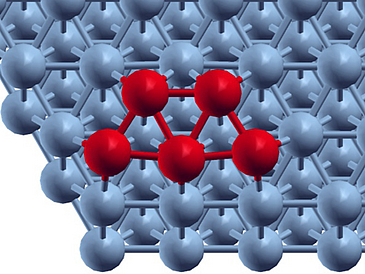Researchers from Hamburg, Bremen and Jülich are now able to produce the smallest-possible stable magnets: They comprise just five atoms. The current issue of “Science” carries an article entitled the “Current-driven spin dynamics of artificially constructed quantum magnets” in which they explain how magnets behave when downscaled to atomic dimensions. The University of Bremen’s Institute of Theoretical Physics and the Bremen Center for Computational Materials Science are partners in the research project that produced the spectacular results.
Although many of us may not be aware of it, magnets are part of our everyday lives and can be found in applications on quite different size scales: From a meter upwards in power engineering, through centimeter-sized magnetic compasses, down to the range of just some ten nanometers in information technology. Despite their varying sizes, all magnets have one thing in common. They always exhibit a clearly defined north and south pole, which is what makes them so useful in so many applications. However: This is not true for the incredibly small magnetic components in the nano range, i.e. for individual atoms. On this scale researchers have discovered quite different quantum effects. The poles of these magnets become unstable and move at random. This makes them most unsuitable for applications like the storage of data, for instance.
What happens, though, when we try to produce magnets comprising just a small number of atoms? And how big does a magnet have to be before it exhibits stable poles? These are the questions researchers from the Universities of Bremen and Hamburg and the Jülich research center have been investigating – and they have come up with some surprising answers.
Interaction between practical experiment and theoretical calculation
Working at extremely low temperatures on a copper surface, researchers from the University of Hamburg used a magnetically sensitive type of scanning tunnel microscopy to create small clusters of ice atoms comprising just five atoms each. This was rather like playing with LEGO blocks on an atomic scale. It is very important for fundamental research because it enables researchers to develop and verify theoretical considerations linked with nanomagnetic structures.
With the help of theoretical calculations performed by the Bremen researchers, it then became possible to show how the ice atoms arrange themselves on the underlying surface according to two possible structures: Either like a tiny pyramid or like a flat atomic “spot”. On the atomic scale, the arrangement of each individual atom determines how such a cluster will behave as a whole. Subsequent additional calculations obtained by the teams in Bremen and Jülich for the clusters in question revealed that the magnetism of the individual atoms interact constructively and the clusters behave outwardly as in unity – as a spin. By atomic standards, this spin is quite considerable – but still only a thousand times smaller than the magnetic moment of the nanoparticles found in modern computer hard drives.
Further experiments carried out at the University of Hamburg could now create images of how the nanomagnets behaved and illustrate how stable magnetic poles are formed that can be “switched over” by means of spin-polarized electrical current. They found that near to absolute zero temperature just five atoms are sufficient to obtain a stable magnet, which can then be controlled by exposure to the tiniest electrical current.
Nanomagnetic systems present an enormous challenge for theoretical investigation since the electrons in these systems do not behave independently: Rather, they are “strongly correlated” and “dance” around with each other. Deciphering this “dance” is one of the main objectives pursued by the University of Bremen’s Institute of Theoretical Physics and the Bremen Center for Computational Materials Sciences. The team led by Prof. Tim Wehling is working on the development of theories to describe such strongly correlated electron systems that will also be able to predict the outcomes. Although still a long way off (especially due to the very low temperatures required for experiments), one day such theories could form the basis for producing customized stable magnetic nanostructures that will serve as innovative components capable of being used in information technology.
For f urther information, please contact:
urther information, please contact:
Universität Bremen
Fachbereich Physik / Elektrotechnik
Prof.Dr. Tim Wehling
Institut für Theoretische Physik
Bremen Center for Computational Materials Science
Phone: +49 421 218 62039
e-mail: wehlingprotect me ?!itp.uni-bremenprotect me ?!.de


